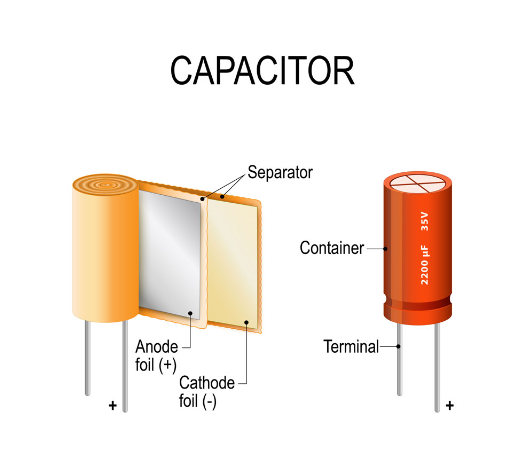
Capacitors are fundamental components in electronic circuits, storing and releasing electrical energy. They come in various types, sizes, and configurations, each with its specific characteristics and applications. One critical aspect of capacitors often overlooked is their polarity. Polarity refers to the orientation of positive and negative terminals within a capacitor, and it plays a crucial role in their functionality and application.
This comprehensive guide aims to delve into the intricate world of capacitor polarity, covering its significance, types of polarized and non-polarized capacitors, applications, considerations, and methods to identify and manage polarity-related issues.
What is Capacitor Polarity?
Capacitors, at their core, consist of two conductive plates separated by a dielectric material. In polarized capacitors, such as electrolytic and tantalum capacitors, the dielectric material allows the flow of current in one direction while significantly limiting it in the reverse direction. Hence, these capacitors have distinct positive and negative terminals, and reversing the polarity can lead to catastrophic failure or damage.
Non-polarized capacitors, like ceramic, film, and some types of electrolytic capacitors, lack a specific polarity. They can be connected in any orientation within a circuit without risking malfunction.
Types of Polarized Capacitors
Electrolytic Capacitors: These capacitors are widely used due to their high capacitance values and compact sizes. They consist of an electrolyte and typically have a marked negative terminal. Connecting them with the wrong polarity can cause overheating, leakage, or even explosion.
Tantalum Capacitors: Known for their stability and reliability, tantalum capacitors are smaller than electrolytic ones but offer similar characteristics. They also have polarity, with the positive terminal usually marked.
Non-Polarized Capacitors
Ceramic Capacitors: These capacitors are non-polarized and find extensive use in various applications due to their wide range of capacitance values and high-frequency response.
Film Capacitors: Film capacitors, made of a thin plastic film as the dielectric, are also non-polarized and are known for their stability, low leakage, and high tolerance for temperature variations.
Importance of Polarity in Capacitors
Understanding capacitor polarity is crucial for several reasons:
Preventing Damage: Incorrect polarity can lead to capacitor failure, overheating, leakage, or even explosion in polarized capacitors.
Circuit Functionality: In circuits where the polarity matters, using the wrong type of capacitor can disrupt the circuit’s performance or render it non-functional.
Safety Considerations: Capacitors, especially larger ones, can store significant amounts of electrical charge. Reversing polarity could release this charge unexpectedly, posing safety hazards.
Identifying Polarity and Proper Usage
Polarized capacitors usually have clear markings denoting their polarity. They might have a stripe, arrow, or minus sign indicating the negative terminal. It’s vital to adhere strictly to these markings when integrating capacitors into a circuit.
When using non-polarized capacitors, polarity is not a concern. However, considering their capacitance, voltage ratings, and temperature coefficients is essential for optimal performance.
Applications and Capacitor Polarity Considerations
Power Supply Filtering: Electrolytic capacitors are often used in power supply circuits to smooth out voltage fluctuations. Correct polarity is critical to their functioning.
Audio Systems: Capacitors are integral to filtering and signal coupling in audio circuits. Polarity-sensitive capacitors should be correctly aligned to avoid distortion or damage.
Timing Circuits: Some circuits, especially those involving oscillators or timing circuits, rely on capacitors where polarity can affect the timing accuracy and functionality.
Managing Polarity-Related Issues
Double-Checking Connections: Before powering a circuit, ensure the correct orientation of polarized capacitors. Reversing their polarity can lead to irreversible damage.
Testing and Replacement: If unsure about a capacitor’s polarity, use a multimeter to verify or replace it with one that clearly indicates polarity.
Polarity Protection Circuits: In critical applications, incorporating protection circuits can prevent damage due to reversed polarity.
Conclusion
Capacitor polarity is a crucial aspect of electronic design and implementation. Whether dealing with polarized or non-polarized capacitors, understanding their polarity, markings, and implications within a circuit is vital for functionality, safety, and longevity. Attention to polarity ensures that capacitors operate as intended, contributing effectively to the performance of electronic systems without risking damage or malfunction.
